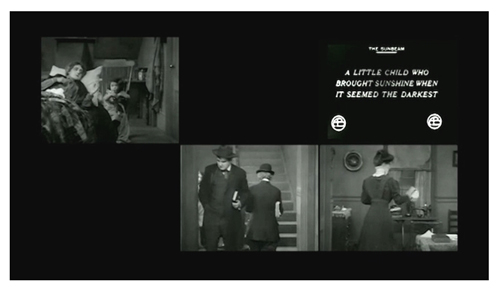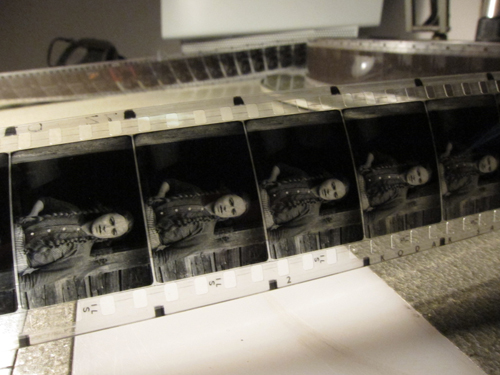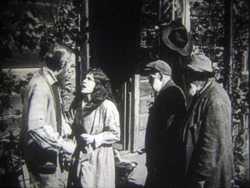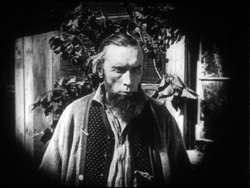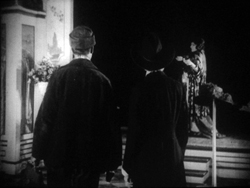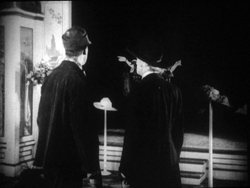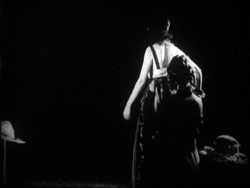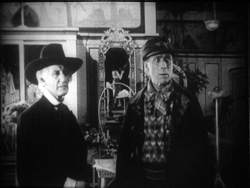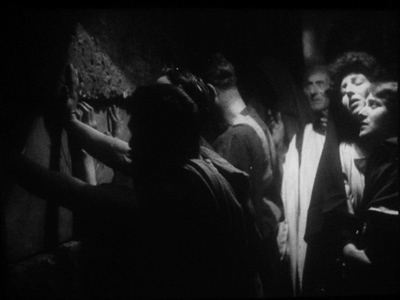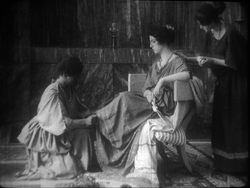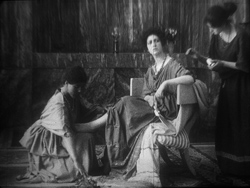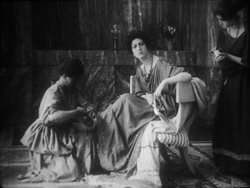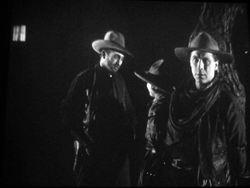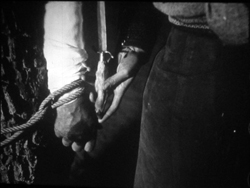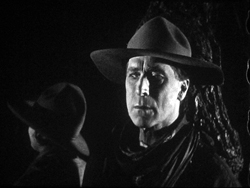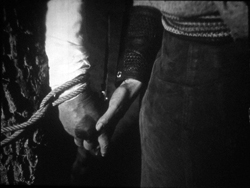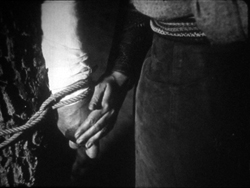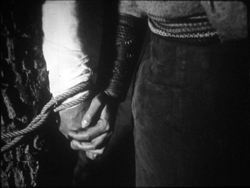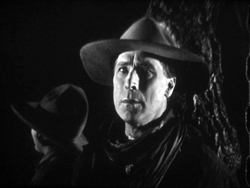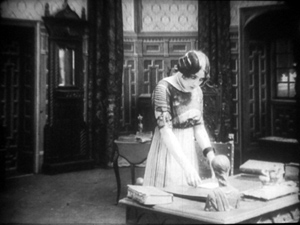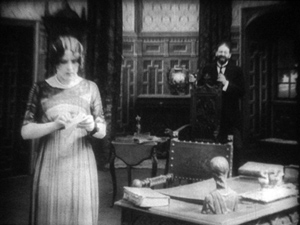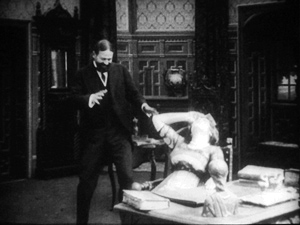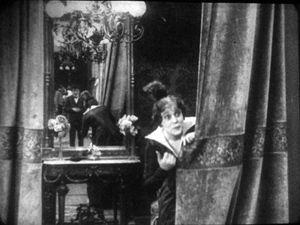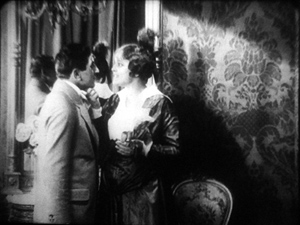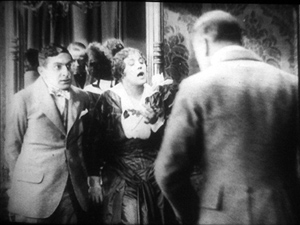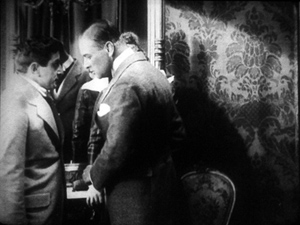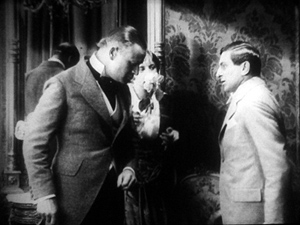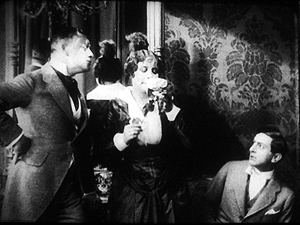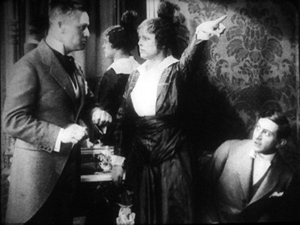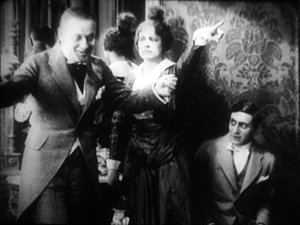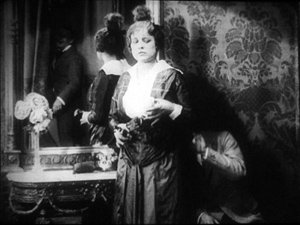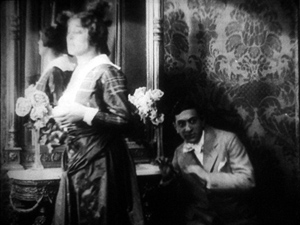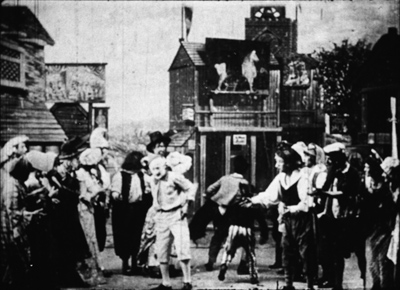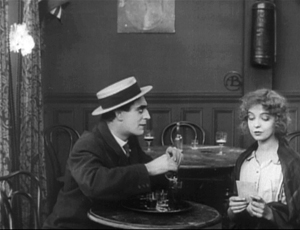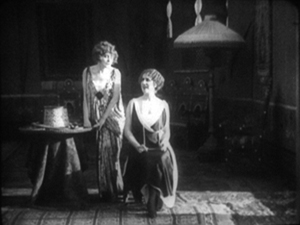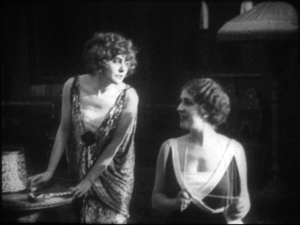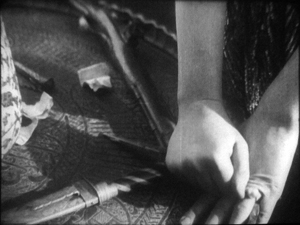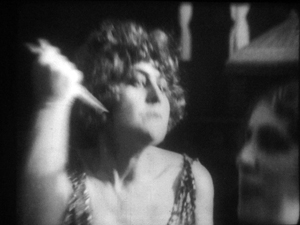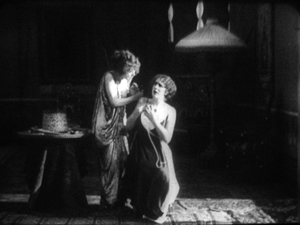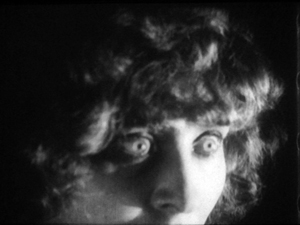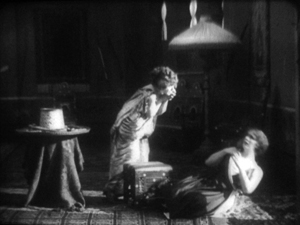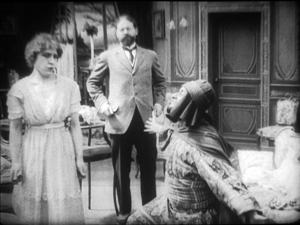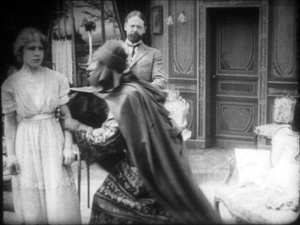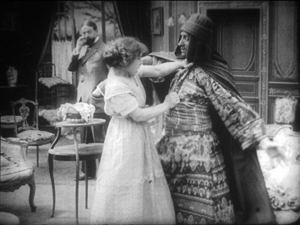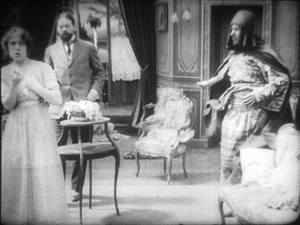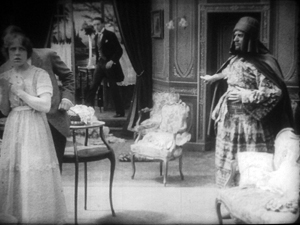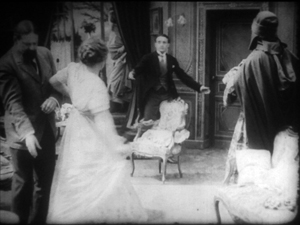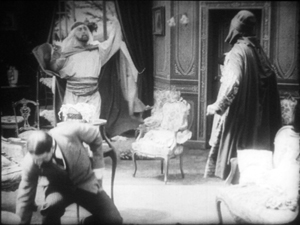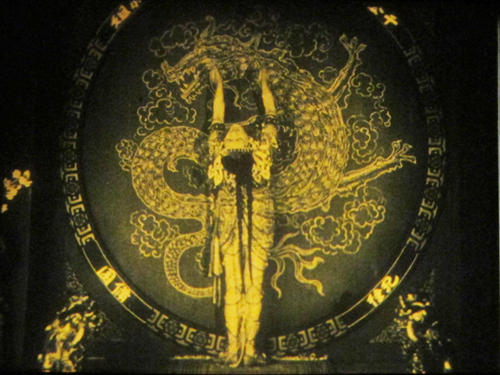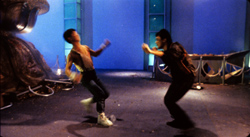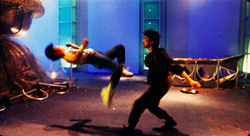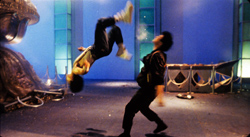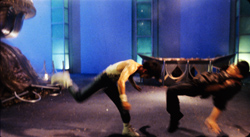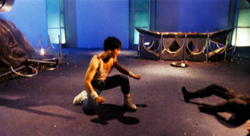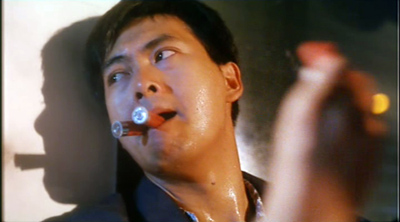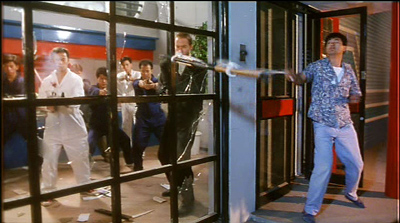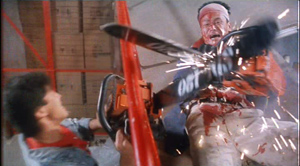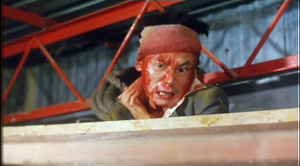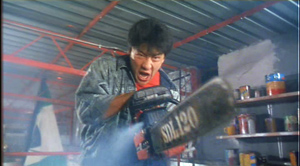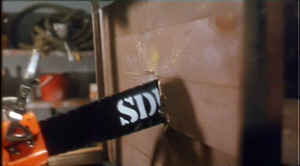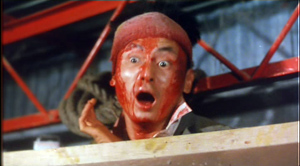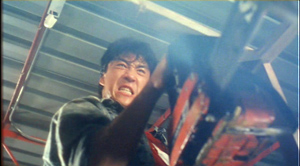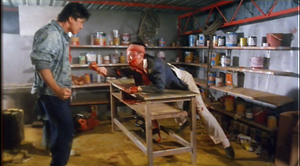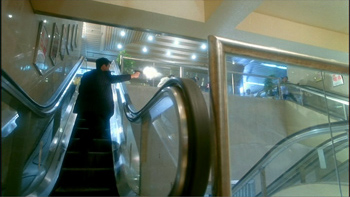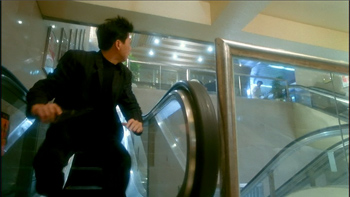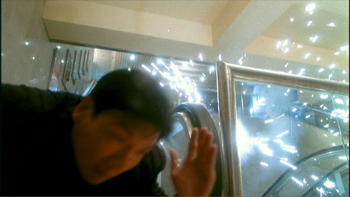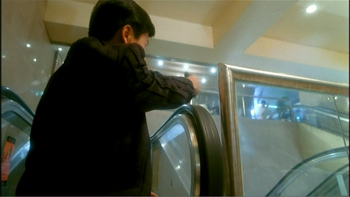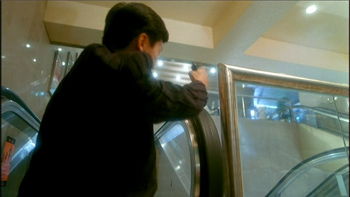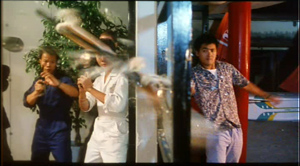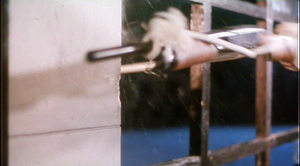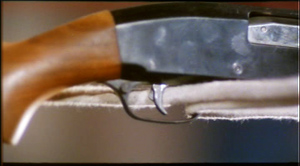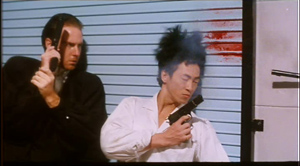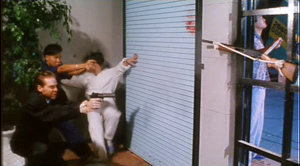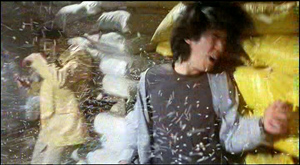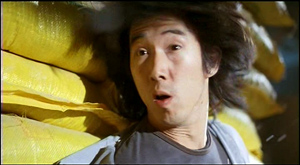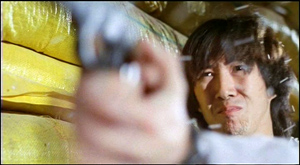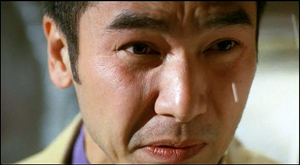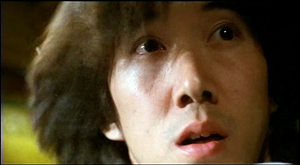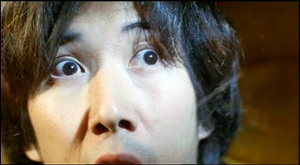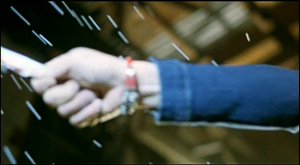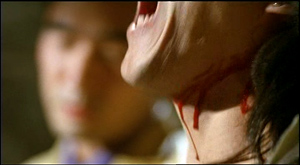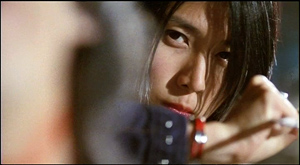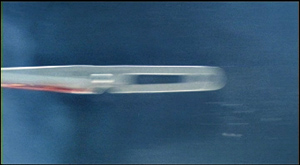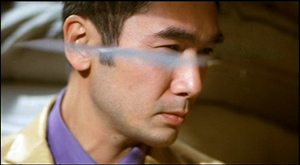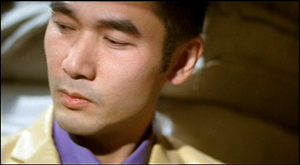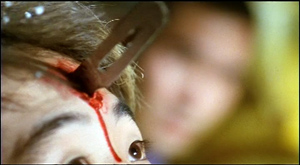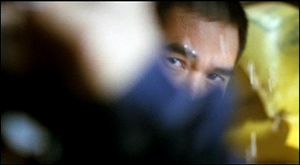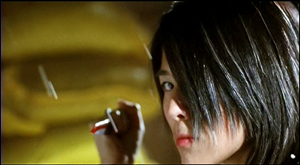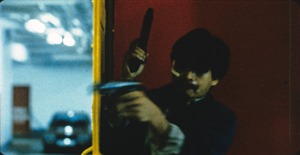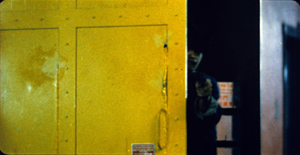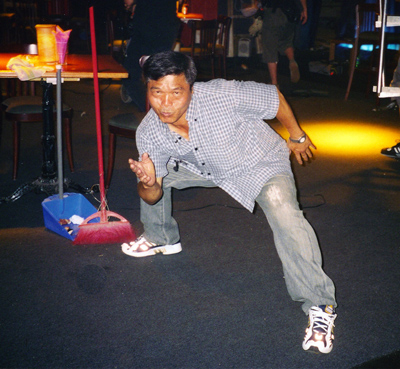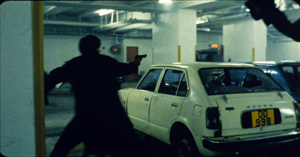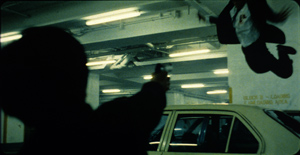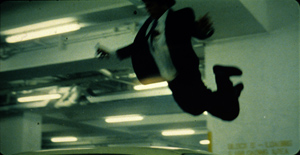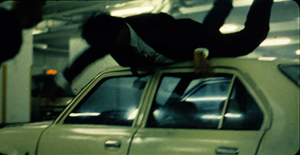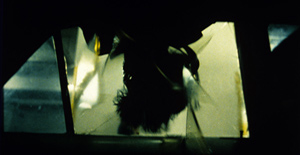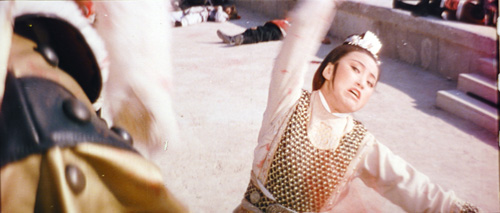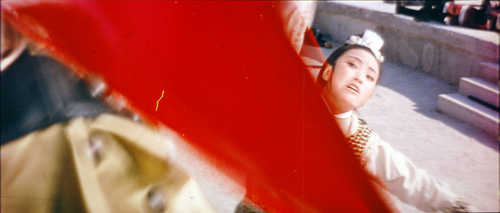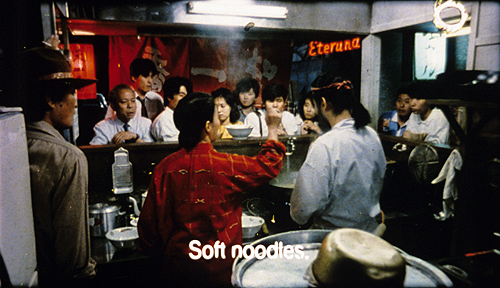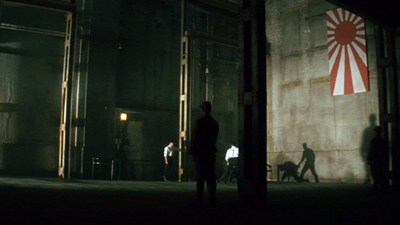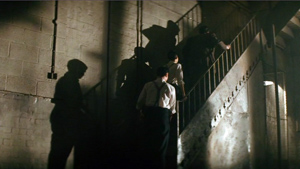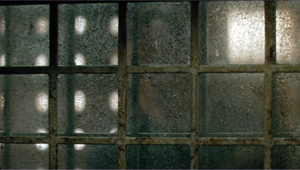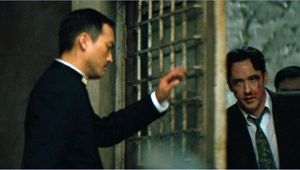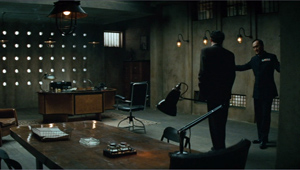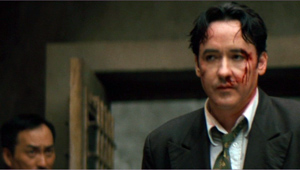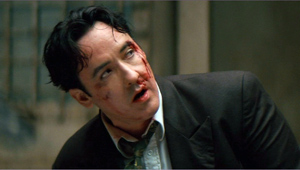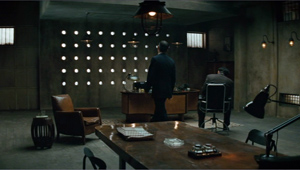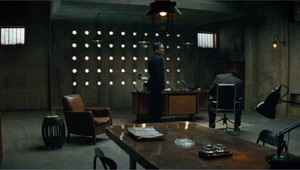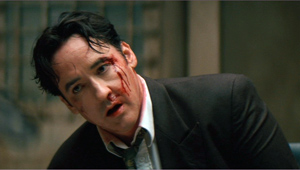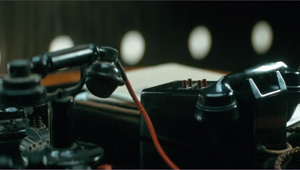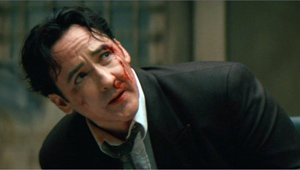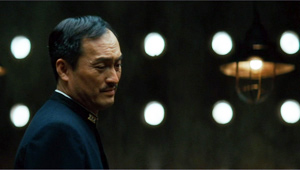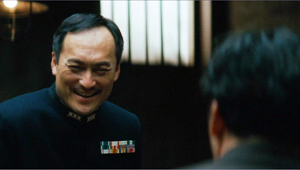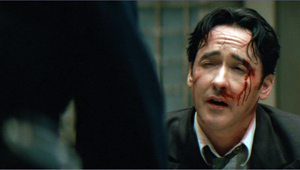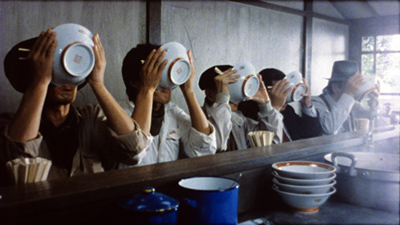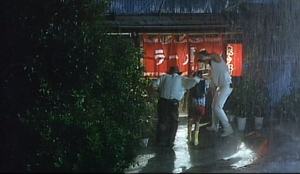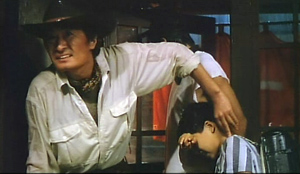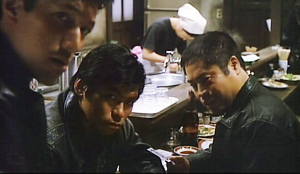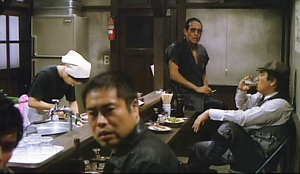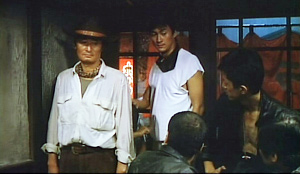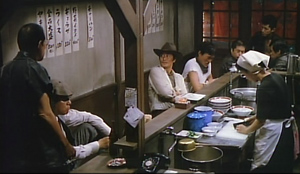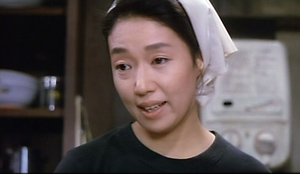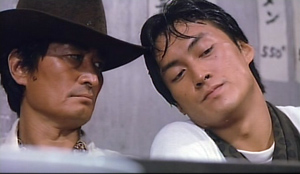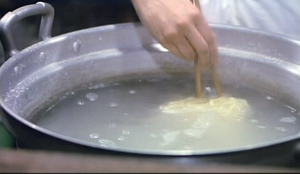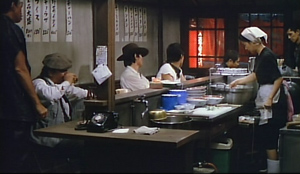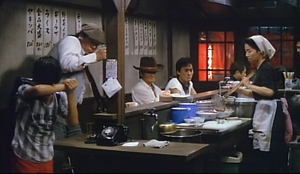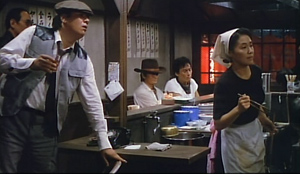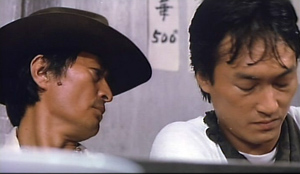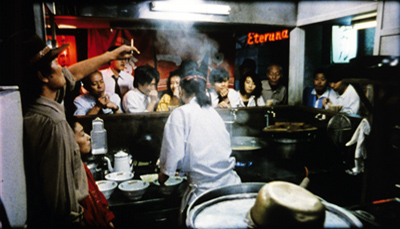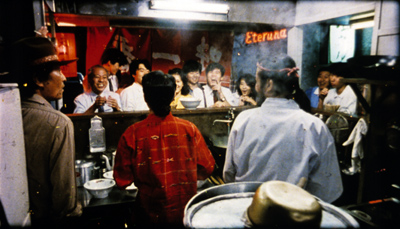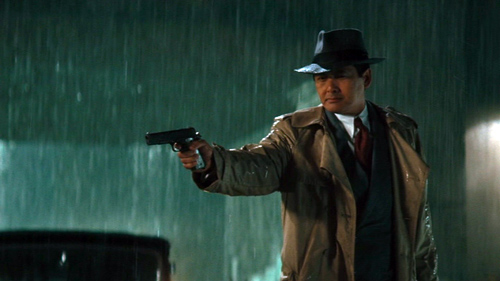Archive for the 'Film technique: Staging' Category
A variation on a sunbeam: Exploring a Griffith Biograph film
Kristin here:
On April 21 a young Spanish film student uploaded his remarkable little film, Variation: The Sunbeam, David W. Griffith, 1912 onto Vimeo. There it languished, like so many contributions to the internet, good and bad. In the first four months of its presence on the site, it attracted 17 views.
Then, on August 17, Variation was viewed twice and earned its first “Like.” (One has to be a member of Vimeo to Like a film, so one cannot assume that none of its viewers to that point had enjoyed it.) That first Like, and perhaps both views were by Kevin B. Lee, best known for his many video essays on classic films. (See here for an index; I contributed the commentary for the La roue entry.) Over the next week and a half there were five additional views, four on August 28. I suspect some or all of these last ones were repeat visits by Kevin, since on August 31 he was the first to post an essay on Variation: The Sunbeam, David W. Griffith, 1912 (hereafter Variation), along with some information on its maker, Aitor Gametxo.
The immediate result was a flurry though not a stampede of views: 33 on August 31, along with a second Like; and 15 on September 1, with a third Like. One of those views and the third Like were mine. On September 2, there were 12 views, dwindling to 2 on September 3 and 1 on September 4.
(Among the viewers after the Fandor entry was Evan Davis, University of Wisconsin-Madison film-studies alumnus, who read Lee’s blog, watched the film, and passed the links along to us. Thanks, Evan!)
It’s a pity that more attention has not been paid to this charming, clever, and informative film. Not only would people enjoy it, but it could easily be used as a tool for those teaching, or indeed researching silent cinema. So here’s my bid to help it go viral.
Variation is a found-footage film based on Griffith’s American Biograph one-reeler The Sunbeam, made in December, 1911, and released on March 18, 1912. It is not among the most famous of the nearly 500 one- and two-reelers Griffith directed at AB between 1908 and 1913, but it’s better known than most. In the opening, a sick mother dies, and her little girl, thinking her mother is asleep, goes out into the hallways of their working-class apartment building. She tries to find someone to play with, but everyone rebuffs her until she manages to charm two lonely people, a bachelor and spinster, who live opposite each other on the floor below the child’s home.
Aitor noticed three key things about the film. First, the action takes place in a very limited space, with the three apartments and hallway all close to each other. Second, the doorways through which the characters pass between these rooms are on the edges of the screen, so that when they exit through the doorway in one shot and after the cut enter the space on the other side of the doorway, there is often a sort of elusive match on action formed (what I termed a “frame cut” in The Classical Hollywood Cinema, p. 205 and figures 16.36 and 37). Third, and perhaps most importantly, Griffith was intercutting actions that were happening simultaneously, so that at many of the cuts, he jumped from the end of an action in one space back in time to catch up with what had been happening in another space. At times he would jump back twice if simultaneous actions were happening in three spaces.
Aitor has taken the individual shots and redone them, putting them into a grid of six small frames, three on the bottom and three at the top. Scenes in the child’s upstairs apartment are shown only in the upper left, the top of the stairway in the upper center, and the two apartments on the ground floor at the sides, with the hallway and bottom of the stairs between them. (See above.) These are roughly the actual positions these spaces occupy in relation to each other in the building represented in the film. The shots run in their true temporal relations, so that there is no jumping back.
I suggest that before reading further, you watch The Sunbeam, especially if you have never seen it before. It would be impossible, I think, to entirely follow the story just from seeing Variation. The shots are so reduced in size to fit into the grid that small but important gestures and details get lost. Here is the original film, from YouTube.
With Aitor’s kind permission, we present his take on Griffith’s one-reeler. (The Sunbeam runs about 15 minutes, but due to the simultaneous presentation of many shots, Variation is only about 10 minutes.) Click on the “Vimeo” logo in the lower right corner for a larger image:
A fascinating film, isn’t it? I think many viewers would reach the end of Variation and wish that the same sort of presentation could be created for other films–at least, early ones that are short enough to make such rearrangement viable. Kevin Lee is enthusiastic about the idea: “Imagine this multi-dimensional, real-time approach being applied to footage from other films, as a way of not just mapping out scenes in a movie, but also gaining insight into filmmaking technique.” It might be possible, but the six-rectangle grid used here would not work for very many films. Aitor has chosen the ideal film for such an approach. Not only are there a limited number of significant characters, but they also live in the same building, with three rooms and a hallway, all viewed from the same direction, making them fit perfectly into a “doll-house” style scene.
Had Griffith not routinely shot directly toward the back wall in all his sets, placing the shots directly side by side across the grid would not work, at least not so neatly. Many other directors of this era were exploring shooting into corners and having doorways for entrances and exits centered at the rear. Perhaps filmmakers like Aitor could still place different shots side by side, but the actors’ movements from one space to another would not be so smooth. One of the attractions of Variation is that those movements are smooth, and as a result the action plays as if it were part of a continuous, “real” film.
Even other Griffith films shot in the style of The Sunbeam would be far more difficult to lay out on a similar grid. Longer rows of more rectangles would need to be added, or the upper row would have to represent actions taking place at a distance and the lower one actions taking place within a building. (I’m thinking here of something like The Lonely Villa, where action in a series of contiguous rooms is intercut with the husband’s race from a distant locale back to his house.) The placement of the bachelor’s room opposite the spinster’s, on either side of the hallway through which all of the minor characters pass, is crucial to Aitor’s project. A complex film with many characters and locales might create a grid with rectangles too small to be grasped by the viewers. Ways of indicating techniques like flashbacks would have to be devised. And of course, not all films contain simultaneous action.
Variation has some technical disadvantages. The titles appear in the upper right corner of the screen, since no locale opposite the child’s apartment is ever shown. The titles are small and difficult to read, and since they pop up simultaneously with the action, it’s almost impossible to read them anyway. One cannot tell where the titles originally came in the flow of shots, though one can always check the original film. Another problem is the cropping of the images on all four sides. The DVD copies are somewhat cropped, and more of the image is eliminated in the Variation frames; the action of the little heroine hiding a hairpiece in the spinster’s home, an important motivation for later action, can barely be grasped because it is so small a detail and happens at the very bottom of the frame; in the DVDs it can be clearly seen.
The Griffith Project and our knowledge of his techniques
I do not intend by any means to diminish what Aitor has accomplished when I say that the three main techniques he works from have been known to Griffith scholars for years. Variation offers a new way of examining and explaining those techniques.
Griffith has, of course, been one of the most closely studied filmmakers in history. A vast summary of and contribution to the research on Griffith was recently compiled by “Il Giornate del Cinema Muto” film festival in Pordenone, Italy. From 1997 to 2008, the festival mounted a nearly complete retrospective of Griffith’s work, hampered only by those films which still exist only as negatives or in other forms that could not be projected. A team of experts divided up the work and wrote extensive program notes for every single film Griffith made, whether it was shown at the festival or not. The notes, some more general essays, and Griffith’s writings were edited into twelve volumes jointly published by the festival and the British Film Institute (1999-2008). I had the privilege of contributing notes to most of the volumes, and although I cannot claim to know Griffith’s entire œuvre intimately, I got to know the films assigned to me quite well and learned a great deal about his methods.
The program notes for The Sunbeam were written by Griffith specialist Russell Merritt (Volume 5, 2001). As these excerpts from his description of the film’s setting indicate, the doll-house arrangement of the sets in The Sunbeam were distinctive, but not atypical of Griffith’s approach:
This was the second of Griffith’s three December tenement films (falling between The Transformation of Mike and The String of Pearls); spatially it is his simplest. Griffith uses only five setups (fewer than half what he works with in The Transformation of Mike and The String of Pearls.), but far from feeling cramped or monotonous, the three rooms and two hallways spaces seem perfectly designed for the playful romps, the practical jokes, and the unfolding of the gentle love story.
By 1911, the Griffith apartment set had developed a personality of its own, or more precisely, had become both distinctive and flexible enough to accommodate a broad range of narratives. Griffith’s planimetric style, with the camera always aimed straight on into the back wall with at least one side of the room aligned to the margin of the frame, had become as much a Biograph signature as the last-minute rescue, the fade-out, parallel editing, and the stock company of actors [….] In The Sunbeam, the familiar hallway and one-room apartments turn into something resembling a row of a child’s wooden blocks or the rooms in a child’s dollhouse, albeit with a dead mother in the garret. In each space, whether the hallway, the spinster’s apartment or the bachelor’s one-room across the hall, there is something to play with or play upon. The prank with the string stretched across the hallway literally links the two apartments and provides the perfect center of a the film–a gag that depends upon the mirror symmetries of the rooms and the tug-of-war actions of the two incipient sweethearts. (p. 196)
For the prank with the stretched string made symmetrical spatially as well as temporally, see below.
Ben Brewster and Lea Jacobs’ book Theatre to Film (1997) points out that cutting among multiple adjacent interior rooms was typical of Griffith’s work in this period: “By early [1911] a film like Three Sisters has a climactic sequence of 28 shots alternating between three set-ups–long-shot views of three rooms, a kitchen, a hall, and a bedroom, which movements from room to room that coincide with cuts establish as side by side.” (p. 189) My own notes for The Griffith Project volumes discuss adjacent sets and room-to-room movements using frame cuts. (See the end of this entry for a list.)
Griffith’s use of editing to convey simultaneous events, as well as to portray thoughts and flashbacks has been extensively discussed in the literature on the director.
What is remarkable is that a 22-year-old film student has noticed these devices and found a simple, elegant method to demonstrate what we already knew, but with greater precision and vividness than could be done with prose analysis. To experts, that is what should make Aitor’s film so appealing.
For example, the precision of Griffith’s matches on action at the frame cuts is illustrated time and again in Variation:
Were it not for the fact that Griffith’s camera is closer to the action in the smaller hallway set than it is in the two outer rooms, the spinster’s move through the door would almost appear to be a single smooth glide. Unless one freezes the frame, as I have done here, some of these movements look uncannily continuous.
For those teaching or reading Film Art: An Introduction, Variation also provides a clear example of story time versus plot time. Griffith’s The Sunbeam presents us plot time, with its jumps backward to cover all the action in multiple locales. Aitor’s film presents story action as we ordinarily would reconstruct it only in our minds. Usually we describe story action with synopses or outlines. To see it played out in real time is a rare treat.
The filmmaker
Aitor has a blog, which contains primarily many lovely still photographs taken in Spain, Ireland, and the United Kingdom. It offers, however, minimal information about him. Kevin Lee wrote to ask him for information, which is included in the Fandor entry linked above. I also emailed Aitor with some questions to further contextualize Variation, and he provided a short summary of his background and his interest in Griffith.
My name is Aitor Gametxo. I was born in Bilbao in 1989 and have been living in Lekeitio. I started the Communication and Film degree in the University of the Basque Country, but I moved to the University of Barcelona to finish it this year. I’m currently living and working in Barcelona, and I’m going to do a “Creative Documentary” masters degree this upcoming year. I really enjoy taking pictures of everyday things and places, as a way of reporting reality. I also love film, specially documentaries, found footage films and cinema-essay pieces. I honestly believe in the power films have to make us think about things. Not only because of the topic the film is about, but also about the way in which the film is made (a kind of dialectics between Bill Nichols’ expository and reflexive modes). I love watching old (and odd) films and thinking about things that are different from the purpose they were created for. (As I told Kevin) we are able to take some footage which is temporally and geographically unconnected to us and remodel, or refix, or remix… it, giving birth to another work. This is the way I see the found-footage praxis.
About this particular film, The Sunbeam, I watched it for the first time just before doing the variation. I knew other works made by Griffith, such as “Intolerance” (quoted in several film history books). But this was unknown for me, so that the first watching was crucial. While I was enjoying it, I was wondering what the place where it was shot looked like. I suddenly imagined it as a two-floor house, where the characters cross in some moments. Also the doors were essential to fix one part with another. This was the main idea where I worked on. It was great fun doing it.
The result is this variation in real-time action of the classic work where we can see how Griffith worked on. It’s like returning back to Griffith’s mind, to the first idea, as he imagined one hundred years ago (!) how The Sunbeam would look like. This is the magic of cinema.
My contributions to The Griffith Project‘s program notes for the Biograph years are these. In Volume 2, January-June 1909: Those Boys; The Fascinating Mrs. Francis; Those Awful Hats; The Cord of Life; The Brahma Diamond; Politician’s Love Story; Jones and the Lady Book Agent; His Wife’s Mother; The Golden Louis; and His Ward’s Love. In Volume 3, July-December 1909: Lines of White on a Sullen Sea; In the Watches of the Night; What’s Your Hurry?; Nursing a Viper; The Light That Came; The Restoration. In Volume 4, 1910: A Child’s Faith; The Italian Barber; His Trust; His Trust Fulfilled; The Two Paths; and Three Sisters. In Volume 5, 1911: The Lonedale Operator; The Spanish Gypsy; The Broken Cross; The Chief’s Daughter; A Knight of the Road; and Madame Rex. In Volume 6, 1912: The Unwelcome Guest; The New York Hat; My Hero; and The Burglar’s Dilemma. In Volume 7, 1913: The Hero of Little Italy; The Perfidy of Mary; and A Misunderstood Boy.
Like the other contributors, I found myself dealing with a few famous films (e.g., the wonderful Lines of White on a Sullen Sea) and others that were largely unknown. Each little cluster of titles assigned to us consisted of films that had been made sequentially, so that each of us could get an intensive look into Griffith’s work over the course of a few weeks. It proved to be a rewarding way of approaching the study of the director. The general editor for the series was Paulo Cherchi Usai, assisted by Cindi Rowell.
The Sunbeam is also available in the U.S. in two DVD sets: Image’s “D. W. Griffith: Years of Discovery: 1909-1913” and Kino’s “D. W. Griffith’s Biograph Shorts Special Edition.” (The discs can also be bought separately.)
Looking different today?
Johan (1921).
DB here:
Earlier this month Manohla Dargis wrote a New York Times article on how we watch, or should watch, films that some audiences consider slow and boring. She suggested that appreciating such films requires us to cultivate fresh ways of seeing. Her article and my interests coincide on this matter, so I wrote an entry developing some ideas about viewing strategies and skills. This piece also, happily, brought new readers to Tim Smith’s experiment in tracking viewers’ scanning of a scene in There Will Be Blood.
Today I explore another angle on the problem of how to watch movies that aren’t the normal fare. But this time what’s abnormal for us was once normal for everybody. I look at the pictorial possibilities that emerged in the 1910s. Those possibilities are of interest if we want to fully understand film history, but they offer some mysteries as well. If viewing movies involves skills, did people a century ago have the ones we have? Or did they employ different viewing habits, ones that we have to learn?
Editing, your imaginary friend
I write from my annual research trip to the Royal Film Archive of Belgium, now known as the Cinematek. For some years, I’ve been looking into feature filmmaking of the 1910s. On every visit I’ve found rich material, movies off the beaten path that give me a sense of the immense creativity of that early period. (See the bottom of this post for links.) The official classics of these years, by Chaplin and Griffith and Fairbanks and Bauer and Gance and Sjõström and Feuillade, remain remarkable, and Kristin’s latest entry makes a case that Alberto Capellani belongs among this heroic company. But you can also find extraordinary moments in ordinary movies. Even the most banal film has something to teach me about what choices faced the era’s filmmakers.
One of those teachable elements involves the ways in which directors guide our attention. We know that editing serves to shift our attention from one part of a scene to another, but so does judicious staging. This is one of the great lessons of the cinema of the 1910s. Watching films from that period convinced me that the craftsmanship of Anderson in There Will Be Blood, and of other directors reliant on long-take ensemble staging, has deep roots in filmmaking tradition. But the golden age of cinematic staging was relatively brief, and it was eclipsed by an approach based largely on editing. That approach is, essentially, still with us.
Let’s start by appreciating the technique that became most prominent. By the late 1910s, Hollywood filmmakers had more or less perfected what we’ve come to call the classic continuity editing system. The camera could penetrate the most intimate exchange, breaking it up into intelligible bits. Here, in a minor Metro film called False Evidence (1919), Madelon tries to persuade her father that she, not her boyfriend, is responsible for a crime.
After giving us father and daughter close together in profile, the camera has somehow squirmed in between them, showing each one in a tight 3/4 view. Or rather, the cutting has forced the staging to pull the characters a bit apart so that each one can have a frame to him- or herself. Spatial plausibility gives way to dramatic urgency; what we care about are clear views of their emotional responses. As long as the spatial relations remain clear, they can be just approximately consistent.
For a little more finesse, we can look–as usual–to Rio Jim. William S. Hart’s films are among the most visually elegant and ambitious of this period, and even his less-known items seldom disappoint. John Petticoats (1919) gives us “Hardwood” John Haynes, a rough-edged logger who finds he has inherited a New Orleans dressmaking shop. His comic introduction to the place, in the company of a new friend he’s made, uses editing to tease us. The two gents come in, with John bewildered by a feminine world he’s never known. They pause before a model sashaying on the stage, and when she pauses, she’s blocked by the Judge’s body.
We’re left without the revelation of her appearance, but when her dresser comes forward to peel off her wrap, we cut, in effect, “through” the Judge to get a clear view of the disrobing. The blocked shot teased us, but the cut pays us off.
Now that the model bares a lot more than before, the biggest tease begins. How will John react? The answer is given in the next shot, a nearly 180-degree shift from the earlier framing of the men that incorporates a mirror in the background to keep the model onscreen.
Thanks to a cut, action and reaction are given in the same shot–in fact in the same zone of the frame, the center.
A pass, a pat, a squeeze
Fabiola (1918).
Many European directors were moving in the same direction as Lambert Hillyer in John Petticoats. Although they might not use as many shots or as many different angles as their American counterparts, they were confidently breaking their scenes up into closer views, often through axial cuts that take us straight into or out of the action, along the lens axis.
Take Enrico Guazzoni’s Fabiola (1918), henceforth known to me as Fabulosa. Normally I consider the Roman oppression of Christianity one of the least fertile topics for a good movie, but Fabiola proves me wrong. For one thing, the title names a rather unpleasant woman who barely figures in the action until the climax. For another, Guazzoni proves an adept filmmaker. I was struck by those immense sets that distinguish the Italian costume drama, the dazzling lighting (see above), and the skilful editing.
Our introduction to Fabiola comes as she sits disdainfully in her household, attended by servants. After a long shot showing off the set, an axial cut takes us closer to her.
She turns as her tardy servant Sira comes in. Having stretched her elegant neck, Fabiola tips her head forward slightly, in a bob of disdain.
Another axial cut takes us still closer to her. And in a few frames her gesture, at once haughty and angry, is repeated. (The streak across the first image below is the splice, so this is the very first frame of the next shot.)
This, I think, is no mistake. The matches on action elsewhere in the film are quite precise, and indeed earlier Italian films have shown that directors used this device skilfully. Guazzoni wanted to stress Fabiola’s head movement, and he used the same tactic, the overlapped action match, that some Americans would use and that many Soviet directors drew on later. This slight accentuation of Fabiola’s gesture is a vivid way to introduce the character, caught in a characteristically scowling moment. Very soon, in a fit of pique she’ll jab Sira with a hatpin.
On the whole, keeping the setups close to the camera axis is the default value in Fabiola. For the Americans, though, cutting made the camera almost ubiquitous. A year after John Petticoats, O’Malley of the Mounted (1920), lets Lambert Hillyer again resort to intelligible shifts of setups. O’Malley, played by Hart, has gone undercover to track a killer. Posing as a robber, he has joined an outlaw gang, but they’ve discovered he’s betrayed them and plan to hang him at sunup. He’s lashed to a tree and guarded by his enemy, the brutal Big Judson. But Rose Lanier, who has drifted along with the gang, is going to help O’Malley escape. The cutting will show us exactly how she does it, and why.
Rose interposes herself between Big and O’Malley, chatting up the thug. A cut of about 180 degrees takes us to the opposite side of the tree and shows her slipping a knife toward O’Malley’s hand. We’re so familiar with this sort of insert that we’re likely to forget that once it was fresh.
O’Malley starts, then shifts his gaze toward Big.
Then comes a simple, remarkable shot. Rose slips the knife to O’Malley. Then she pats his hand. Then she gives it a squeeze.
Mystery and charm of the American cinema, as Godard would say: a single cut-in of hands can give us a lot. First there’s the narrative information (I’m passing you the knife), then Rose’s expression of support (Good luck!), capped by a burst of affection (I love you). The whole thing takes less time than I’ve used to tell it. Surely this ability to invest plot-driven detail shots with heartfelt emotion helped American cinema conquer the world. I’m tempted to say that we could sum up of the power of Hollywood, in its laconic prime, with that formula: the pass, the pat, the squeeze.
This shot is as compact in its expression as the previous one. It’s impossible to capture here all the emotions that flit across O’Malley’s face: hope of eluding death, realization that Rose loves him, anxiety that surviving will make him choose between love and duty. Rose’s brother is the killer he’s been tracking, and in a perversely honorable way O’Malley had looked forward to being hanged. That would have spared him arresting the boy. Now he must live, enforce the law, and lose the woman who has saved him.
I saw some European films that absorbed such continuity tactics quite deeply. Above all, Mauritz Stiller’s Song of the Scarlet Flower (Sangen om den Eldroda Blomman, 1919) and Johan (1921) relied heavily on analytical editing in the American fashion, including angled shot/ reverse shot. As in Fabiola, some of the discontinuous cuts have their own logic. I wish I had time to explore those Stiller films in more detail–particularly their use of turbulent rivers as dynamic plot elements, not mere landscapes. Maybe in some future entry….
Four-quadrant style
Before they adopted the analytical editing characteristic of American cinema, directors were still able to guide our attention. The so-called “tableau” style, about which I’ve waxed enthusiastic on this site before, became a rich tradition in the 1910s. Editing within the scene is minimized. (Apparently most European directors didn’t consider it a creative option in its own right until later in the decade.) The drama is carried by performance and ensemble staging. Relying on movement, acting, and composition, the director controls where we look and when we look at it
To take a straightforward example, consider the rather ordinary melodrama Le Calvaire de Mignon (Mignon’s Calvary, 1917). The scheming and dissolute Dénis de Kerouan wants to wreak misery on his brother Robert. While Robert is out of the country, Dénis hires a forger to fabricate a letter indicating that Robert has a mistress. Dénis leaves the letter on the desk for Robert’s wife to find.
Dénis has exited through the central entryway, and into the empty study comes Robert’s wife. She discovers the letter.
She moves to the left foreground and starts examining it. At this point Dénis’ face peeps out from behind the central curtain. The director makes it easy for us to notice him because nothing else is happening in the set, and Denis’ face is rather close to the wife’s. It’s almost as if he’s looking over her shoulder.
Once we register Dénis’ presence, the director can proceed to balance the shot. All that empty real estate on the right of the frame asks to be filled, and that’s what happens.
When the wife reads the damning letter, she collapses rightward into the chair, just as Dénis rushes forward to take charge of the situation.
This move exemplifies the staging technique known as the Cross, which motivates the switching of characters’ positions in the frame.
Simple as it is, this portion of the prologue of Le Calvaire de Mignon shows how, without cutting, a director can steer us to one or another zone of the shot through such cues as faces, centering, proximity to points of emphasis, and movement. Something similar happens in one, more striking moment of another fairly unexceptional movie from the period.
Nobody will claim Der Stoltz der Firma (The Boss of the Firm, 1914) is a masterpiece, or its director Carl Wilhelm is a master. It’s one of the many comedies in which Ernst Lubitsch starred before becoming a director. Here he’s Siegismund, a bumbling young provincial with more aspirations than abilities, who simply lucks into marrying the boss’s daughter. On the way to the happy ending, he wins the patronage of a fashion designer, Lilly, whose husband finds her flirtation with the young parvenu none too innocent.
Wilhelm’s use of the tableau approach isn’t especially dynamic in most of the film, but there’s one flashy scene. Wilhelm gets us to watch a very small, tight area of the frame and then gently swings our attention to a wider swath of action. As usual, everything depends on a sort of task-commitment on our part: Watch what’s likely to forward or enrich the ongoing narrative.
Lilly lures Siegismund into a changing room, with the composition showing him reflected in a mirror behind her. This sets up an item of setting that will be central to the scene.
Once inside, he coyly presents her with a flower and they draw close together. Since we tend to concentrate on faces, the small area encompassing their two profiles is likely to draw our attention. Nonetheless, the shot is notably unbalanced, as if anticipating something coming in from the right side.
Abruptly Siegismund and Lilly draw apart, and the space between them, in the mirror, is filled by the face of Lilly’s husband, coming through the curtain.
I’d bet that a Tim Smith experiment would find that nearly every spectator is already watching this small zone in the upper left quadrant of the shot. Faces, especially frontally positioned ones, command our notice, and thanks to the mirror we here have three of them. Moreover, movement is an attention-getter too, and all three faces are in motion. Mr. Maas’s face, in fact, gets notably bigger and clearer. His wrathful expression is another reason to watch him.
The husband’s body enters to fill the frame, then presses into the center of the shot, blotting out Lilly as he faces down Siegismund.
Now the director controls the speed of our gaze quite precisely. Maas slowly rotates, forcing Siegismund to swing from left to right, as if he were attached to the bigger man by a rod. This yields, again, that nice sense of refreshing the frame that we always get from a Cross.
Siegismund collapses into the lower right of the frame, flinching from the fight that’s about to start. Lilly soon shoves aside her husband’s chastisement and melodramatically tells him to leave. “We’re divorcing!” the following intertitle says.
Mr. Maas takes it in stride, shrugging and spreading his arms. He leaves, and thanks to the helpful mirror we can see him chortling as he glances back and passes through the curtain.
If we hadn’t already noticed Siegismund cowering behind Lilly in the lower right quadrant, we will now. Lilly angrily flounces to our left (the Cross again). Siegismund rises to explain he hadn’t meant to cause a rift in the marriage.
We’re back to something like the initial setup, but now with Siegismund centered, the couple further apart, and a less unbalanced frame. The drama, which now consists of Lilly inviting him to tea tomorrow, can proceed from here.
A different way of seeing?
Tom Tom the Piper’s Son (1905).
We’ve become used to editing-driven storytelling, and I’m convinced that we can learn to notice the staging niceties of the tableau alternative. But what if early filmmakers explored some other ways of looking that are far more unfamiliar to us today?
Noël Burch, in his 1990 book Life to Those Shadows, argued that in the first dozen years or so of cinema, movies solicited viewing skills that we lack today. He suggested that early filmmakers often refused to center figures and crammed their frames with so much activity that to our eyes the shots look confused and disorganized. In Tom, Tom, the Piper’s Son (1905), Burch notes, the bustle of the fair, the reliance on an extreme long shot, and the absence of any cutting make the central event, Tom’s swiping of the pig, difficult to catch. In the frame surmounting this section, Tom is making off with the pig in an area just right of center, but the antics of the clown and the response of the crowd may well distract us from the main action.
The result, says Burch, is a mode of filmmaking that demanded
a topographical reading by the spectator, a reading that could gather signs from all corners of the screen in their quasi-simultaneity, often without very clear or distinctive indices immediately appearing to hierarchise them, to bring to the fore “what counts,” to relegate to the background “what doesn’t count” (p. 154).
Later developments linearized this field of competing attractions, creating a smooth narrative flow “harnessing the spectator’s eye.” Among these developments were the presence of a lecturer at many screenings (telling people what to watch) and, of course, the growth of the continuity editing system. But Burch suggests that the “primitive mode” hung on until about 1914.
A famous example is a shot from Griffith’s Musketeers of Pig Alley (1912). The gangster has lured the Little Lady (Lillian Gish) into a back room and distracts her with a photograph while he tries to dope her drink, in a precursor of date-rape drugging. But the Snapper Kid, another gangster, has been keeping an eye on her and follows. As the gangster starts to pour the drug out, the Kid’s entry is presaged by a whiff of cigarette smoke.
At the crucial moment, we have three things to notice: the Little Lady’s obliviousness, the gangster’s pouring the drug, and the full entrance of the Snapper Kid.
Today’s director would likely resort to editing that shows the doping, then the Kid arriving, then the doping again, and leaving us to infer a vague sense that they’re happening at the same time. Griffith’s choice gives us genuine simultaneity, but at a cost. Two cues compete for our attention: central composition for the drink, major motion on the edge for the Kid’s entry. In my experience, viewers tend to notice the appearance of the Kid, but to miss the business with the drink. (Another passage for Tim Smith to test!) By today’s standards, Griffith has failed as a director, but Burch’s view suggests that 1912 viewers, more sensitive to “all-over” composition, could have registered both actions, perhaps by rapidly scanning back and forth.
During my trip I found a fascinating example of this issue, as well as an apt counterexample. Both involve daggers.
In Maman Poupée (1919), a remarkable Italian film directed by Carmine Gallone, a devoted, somewhat infantile wife learns of her husband’s affair with a society woman. Susetta confronts the mistress and begs her to break off the affair. The woman laughs in her face. What happens next is given in several shots, mostly through axial cuts.
The linear editing, as Burch indicates, lays everything out for us step by step. The close-ups accentuate what is important at each moment: Susetta seizing the dagger, stabbing her rival, and–in a remarkably modern-looking extreme close-up–registering her horror at what she has done.
Two years before, Marcel Simon, the (Belgian!) director of Calvaire de Mignon, handled a similar situation rather differently. The diabolical Dénis, whom we met earlier, has succeeded in destroying his brother’s life. It remains only for him to force Robert’s niece Mignon to marry the Algerian Emir Kalid. Kalid is at first humble, beseeching Mignon to become his bride, but then he gets rough. We might note already that Mignon, while fairly near the camera, hovers close to the left frame edge.
In their tussle, Mignon snatches something from Kalid’s waistband and flings him far away to the right.
What’s up? Mignon has grabbed the Emir’s dagger and stands poised with it pressed to her heart. But we haven’t been able to see that dagger very clearly (no cut-in close-up here, as in Maman Poupée) and she’s returned to her position far off-center. It’s likely that a viewer today wouldn’t understand that she’s holding the men at bay by threatening suicide. Would a 1917 viewer be as uncertain? Would the situation, plus her posture and the men’s hesitation, be enough to get the point across?
Moreover, this moment goes by very quickly. Scarcely has Mignon struck her pose when her true love, René, bursts in behind her–frontal, fairly centered, and moving fast. Meanwhile, Dénis is sneaking up on her, hugging the left frame. Mignon makes a break for René, dropping the still almost indiscernible dagger.
While Mignon and Rene embrace in the right rear doorway, blocked from our view by Kalid, Dénis stoops over. It’s a timely adjustment, giving us full view of the benevolent Le Maire sweeping into the room.
As the two men confront one another–the climax of the scene–director Simon has the effrontery to let Dénis steal the show. He picks up the dagger, which now can be seen more or less plainly, weighs it in his hand, and looks out for a brief, pondering moment.
We seem to have a late example of the Snapper Kid Effect, in which important actions compete for our attention. Is it clumsy direction to perch Mignon on the frame edge as René rushes in, and to let Dénis recover the dagger while we’re supposed to concentrate on the face-off between the two powerful men? Or would audiences have tracked all the strands of action and enjoyed their simultaneity?
On this site and elsewhere, I’ve assumed that directors in the 1910s structured their compositions for what Charles Barr calls “gradation of emphasis,” a fluid pattern of primary and secondary points of attention. I’ve argued as well that Burch exaggerates the decentered, nonlinear compositions of even the earliest years. Many of the films staged by Lumière cameramen are designed cogently, and so are many films from the 1900s. (Tom, Tom might be the exception rather than the norm.) Yet every so often, you get a later case, like Musketeers of Pig Alley or Le Calvaire de Mignon, that suggests that some viewers might have been more adept at tracking simultaneous events than we are.
A still broader question remains. Let’s assume that people were able to follow and enjoy films in the tableau style, even when that style pushed toward illegibility. What enabled people to adapt, and so quickly, to continuity-based movies? Some scholars and filmmakers argue that continuity editing achieved its power and worldwide acceptance because it mimics our natural mode of perception. At any moment, we’re concentrating on just a small portion of our surroundings, and this is like what editing does for us in a scene. On the other side, Burch and others would argue that continuity filmmaking is only one style among others, with no special purchase on our normal proclivities. On this view, classical continuity’s apparent naturalness hides all the artifice that goes into it, and this concealment makes its work somewhat insidious. I’ve offered some thoughts on this problem elsewhere, but I bet I tackle it again on this site some time.
In any case, we need to study films that seem odd or difficult, whether they’re recent or from the distant past. We’re guaranteed to find some striking and unpredictable things that provoke us into thinking. That’s one of the pleasures of exploring the history of film as an art.
For earlier studies of the tableau style on this site, see this entry on Bauer, this one on 1913 films, this one on Feuillade, and this one on Danish classics. This entry discusses the emergence of Hollywood-style continuity, and this one explores the exemplary editing in William S. Hart films. I go into more detail in two books, On the History of Film Style (chapters four and six) and Figures Traced in Light (chapter two) and in the essay, “Convention, Construction, and Cinematic Vision” in Poetics of Cinema. The last-named piece tries to stake out a middle position on the “naturalness” of continuity editing. Kristin has analyzed Alberto Capellani’s films as instances of the tableau trend, last year here and just last week here. She also weighs in on the debate about whether viewers of his time were better prepared to grasp the action than we are. More generally, Capellani’s career exemplifies the major and swift stylistic changes of the 1910s. When he went to America, he became pretty adept at the emerging continuity style, as the Nazimova vehicle The Red Lantern (1919) indicates. Of course that’s got some striking single images too.
The Red Lantern (1919).
PLANET HONG KONG: The dragon dances
The Iceman Cometh (aka Time Warriors, 1989).
DB here:
Planet Hong Kong, in a second edition, is now available as a pdf file. It can be ordered on this page, which gives more information about the new version and reprints the 2000 Preface. I take this opportunity to thank Meg Hamel, who edited and designed the book and put it online.
As a sort of celebration, for a short while I’ll run a daily string of entries about Hong Kong cinema. These go beyond the book in dealing with things I didn’t have a chance to raise in the text. This is the third one. The first, a list of about 25 Hong Kong classics, is here. The second, an overview of the decline of the industry, is here. The fourth is a photo portfolio showing some stars; it’s here. Then comes an entry on western fandom, a photo gallery of director snapshots, and finally some reflections on the value of film festivals, capped by a list of some personal favorites. Thanks to Kristin for stepping aside and postponing her entry on 3D.
The longest chapter of Planet Hong Kong deals with action films. Here are some further thoughts on this fascinating genre.
Four aces of action
Tiger on Beat (1988).
Directing any action sequence poses several tasks. Once the stunts are decided upon, I can think of at least four such tasks.
1. The filmmakers need to present the physical actions clearly enough for the viewer to grasp them. Who hits whom, and how? What did X do to duck Y’s bullet? Which car is pursuing, which one is fleeing?
2. If the fight or chase is to be prolonged, one needs to come up with a series of phases that take the action into different areas of a locale, or into ever more dangerous situations. The classic arc is a fistfight that pushes the combatants to the edge of a cliff or roof, with the protagonist about to be shoved over. In other words, the action scene typically has a structure of buildup.
3. An action scene can express the emotions of the fighters—perhaps wrathful vengefulness on the part of one, versus cold calculation on the part of the other.
4. Finally, the filmmaker might want to try for a physical impact on the viewer. Just as sad scenes can make us cry and comic scenes can make us laugh, action scenes can get us pumped up. We can respond physically: we can tense up, blink, recoil, twist in our seat, and so on. How can the filmmaker achieve the level of engagement that Yuen Woo-ping emphasized in an interview with me: “to make the viewer feel the blow.”
I think that 1 and 2 are basic craft skills, with 3 and 4 being measures of higher ambitions on the part of filmmakers. Not everyone agrees. Philip Noyce says that incoherence (i.e., lack of clarity) is no problem:
I don’t necessarily think the audience member is looking for coherence; they are looking for a visceral experience. If they want coherence they can watch television.
Put aside the last comment, which begs for a bit more explanation. Noyce goes on to suggest a common rationale for lack of clarity: if the action’s confusing, it’s because the character is confused too. He praises Paul Greengrass’s framing and cutting in the Bourne films because
. . . The camera was used for its visceral possibilities rather than its literal ability. We felt the chase from the inside, where sometimes disorientation becomes an asset because it’s all about the velocity. Sometimes the pursuer and pursued don’t know where they are in relation to each other.
Greengrass’s fans have employed a similar argument, not so far from Stallone’s claims about The Expendables. It seems that many contemporary directors have concentrated on the fourth task, and to some extent the third, the expressive one (but only if the fighters’ emotion is disorientation). Job 1, basic and clear presentation, has become less important.
Yet it seems to me that the contemporary blur-o-vision technique doesn’t create a very sharp or nuanced impact. In effect, filmmakers try to amp up our response through jerky cutting, bumpy camerawork, and aggressive sound (which may be a major source of any arousal the movie yields). The result often doesn’t depend on what the actors do and instead reflects what can be fudged in shooting or postproduction. But we’re wired to react quite precisely to the movements made by living beings, human or not. If the film doesn’t make those movements at least minimally clear, we’re unlikely to sense anything more than a frantic muddle.
Further, Noyce doesn’t consider the possibility that a vigorous visceral effect can be created in and through coherent presentation of the action. The choice isn’t either/ or. The Asian action tradition, especially as practiced in Hong Kong, shows that we can have the whole package, often in quite elegant form.
OTT is OK
The Hong Kong tradition is probably most evident in its resourcefulness in fulfilling Task no. 2: creating an escalating pattern of mayhem and hairbreadth escapes. Filmmakers have been quite inventive in dreaming up outlandish twists in the action. The climax of Tiger on Beat (1988), from master Lau Kar-leung, indulges in what fans would call OTT (over-the-top) stuff. Above, outside a shop selling sailboats, Chow Yun-fat uses a clothesline to snap his shotgun out and blast the gang inside—becoming a literal gunslinger. Stepping up the intensity, Conan Lee Yuen-ba gets to work in a chainsaw duet.
The striking thing is that such flagrantly loopy combat is quite exciting, even exhilarating, while the realism that Noyce and Stallone promote can leave us fairly unmoved. Lesson: Artificially shaped grace can be tremendously arousing. Don’t forget how people get carried away watching dancing, acrobatics, or basketball.
I’ve speculated that the blur-o-vision action style is popular in Hollywood partly because it can suggest violence without showing it, so the sacred PG-13 rating isn’t at risk. No such qualms afflict Lau Kar-leung, who shows the main villain pinned to a table by Lee’s chainsaw. OTT again.
Note that each shot is from a different camera setup, typical of the Hong Kong “sequence-shooting” method. In addition, the whole scene integrates many elements of the setting into the fight. You get the impression that a Hong Kong action choreographer, stepping into a barber shop or a hotel lobby, instinctively thinks: What could be a weapon? What offers cover if someone rushes in with a gun? The Tiger shop yields barrels of paint, chainsaws, and worktables that can collapse under a man’s second-story fall. Even more exhaustive (and exhausting) is the classic fight at the end of Bodyguard from Beijing (1994). Here Corey Yuen Kwai, locking his antagonists in a modern kitchen, makes punitive use of not just knives and cutting boards but also the faucet and dish towels.
So part of what engages us in Hong Kong action is the filmmakers’ inventiveness in finding new ways to develop the basic premises of fights and chases. But this Tiger on Beat sequence also gives us the action in an utterly clear and cogent way. Every shot is brightly lit and crisply composed, with vivid colors in the sets, like those slashes of red. The cutting, while fast, makes everything totally intelligible through matches on action, obedience to the 180-degree rule, and a rock-steady camera. On top of all this, the thrusts and parries are given emotional force through the antagonists’ gestures and expressions (furious, startled, agonized). So conditions 1 through 3 are satisfied.
After this scene, we might ask Philip Noyce: Visceral enough for you?
Cutting to the chase
Matters of clarity, buildup, expressiveness, and impact on the viewer raise the perennial debate among Old China Hands, Martial Arts Division. To cut or not to cut?
For some aficionados, the less cutting the better. In classic kung-fu of the 1970s the full frame and longish take let actors show that they can do real kung-fu. No need to fake it through editing tricks. Actually, though, these films are quickly cut. Directors of the period realized that if the action is cogently composed, you can edit long shots as rapidly as you can close-ups.
No doubt, there are powerful effects you can achieve in the single shot. Admirers of full-frame action can point to an escalator gunfight in God of Gamblers, in which one passage is ingeniously staged in a single deep shot. Ko Chun’ s bodyguard Lung Ng fires at his pursuer in the upper floor.
His opponent falls down the opposite escalator, but another comes up behind, glimpsed in an aperture of the railing, and he fires at Lung.
Lung rises from the extreme foreground to return fire, and in the distance we see his attacker fall out of the slot at the railing.
On the big screen, you can feel your eye leaping from foreground to background, zigzagging across the frame. The dynamism of the action is mimicked in the rapid scanning we execute in taking it in. The eye gets some exercise.
Still, editing can serve my four purposes too. Some of the disjointedness of modern action scenes, we tend to say, comes from the speed of the cutting nowadays. Yet fast cutting can be quite coherent. There are about 490 shots in the twelve-minute climax of Tiger on Beat; nearly all are from different setups, and some are only a few frames long. Since the classic Hong Kong tradition builds upon a commitment to clear rendition of the action, it can use cutting to highlight information or repeat it. At one point, Chow whips his shotgun around a doorway and yanks his rope to pull the trigger on men he can’t see. We get five shots in three seconds.
The shots run, in order, 10 frames, 8 frames, 10 frames, 16 frames, and 38 frames. (I’m a frame-counter.) The lengthiest shot is about 1.5 seconds and the shortest is 1/3rd of a second. Yet each bit of action is so pointedly presented that it’s impossible to misunderstand, while the pace of the cutting forces us to keep up.
At an extreme, we have something like Sharp Guns (2001), a very low-budget, somewhat smarmy actioner that creates two spiky moments out of close-ups. Tricky On, the leader of our hit team, is pinned down alongside a mop-haired thug.
The kid recognizes him and raises his pistol in big close-up.
On, in even tighter close-up looks off, and the kid follows his glance.
A nearly abstract blade slices into the frame and the kid turns, his face going wan from the glare of the metal.
A hand thrusts. A neck bleeds.
Rack focus to On. Cut to Rain, the female assassin. The unfortunate thug’s head in the foreground of each shot specifies where each one is.
The fragmentation intensifies when soon afterward a blade whizzes leftward into the frame. In the next shot it glides past Tricky On.
On follows it with his eyes. Cut to another thuggish head, on his other side, with the blade embedded.
Rack focus again as the body slides down. Cut back to Rain, who has again saved her boss.
We haven’t had a single establishing shot in this sequence. The play of glances and turning heads, along with occasional foreground elements, lets us instantly understand that Rain has protected On from thugs on his left and right. Kuleshov would be happy.
Sharp Guns is surely no masterpiece, and you suspect that the close-up strategy pursued by director Billy Tang Hin-shing was a cheap way out. But give him credit for ingenuity, for well-timed cutting and movement, and for keeping the shots steady and legible. (Handheld shooting would dispel the force of the passage.)
Strongly marked cuts can also contribute a decorative punch. In A Better Tomorrow (1986), Chow is again pinned behind a door, and Woo cuts as he pokes his pistol around the edge.
The burst of that yellow slab in the new shot, counterbalancing the dark red of the earlier one, becomes the pictorial equivalent of a muzzle flash. Wouldn’t you like a bold cut like this in your film?
The pause that refreshes
Choreographer Yuen Bun during the filming of Throw Down (2004).
These are pretty flagrant examples. More commonly, Hong Kong cuts serve to sustain a line of motion or break one off abruptly. Later in the Better Tomorrow gunfight, Chow swivels from one adversary to another, who comes sailing in from above. (Remember: Artifice isn’t bad. And John Woo was an assistant director to Chang Cheh, one of the gurus of the 1970s martial arts cinema. In those movies people fly all the time.)
Woo is famous for using slow motion, but here what prolongs the movement are the cuts. They continue the movement of the thug as he’s hit and starts to fall, but oddly they suspend him in time a bit too.
When he finally descends, the camera pans down with him as he lands on the car. The next shot completes the movement, putting us in the car as his head smashes through the window.
Like the Tiger on Beat sequence, this passage exemplifies what Planet Hong Kong calls the pause/ burst/ pause pattern characteristic of Hong Kong action scenes. In the shots above, the soaring thug enters the first shot 7 frames before the cut. The next two shots run 13 frames and 18 frames. Most interesting is the last shot, the one from inside the car. It lasts 62 frames, making it the longest in the series. 30 of those frames show the thug’s head crashing through the window, but the remaining 32 frames have no movement except for his swaying tie. The sequence has paused for a little more than a second, sealing off this bit of action.
Another editor might have interrupted this last shot while the head was in motion, but the Hong Kong pause/ burst/ pause principle creates a distinct rhythm. A moment of stasis is followed by a stretch of sustained movement, smooth or staccato, building to a peak; then another instant of stasis. This pattern contrasts with the unorganized bustle typical of American films’ sequences.
I think that the Hong Kong tradition has shown what benefits arrive when directors strive to fulfill the first three of my four action tasks. I don’t have time here to go further, but PHK argues that the first three goals form a basis for the fourth—a strong, deeply physical engagement with the action. This need not conform to standards of realism if it galvanizes our eye and accelerates our pulse. What Eisenstein dreamed of, filmmakers in Japan and Hong Kong achieved: a fusillade of cinematic stimuli that pull us into the sheer kinetics of expressive human movement. Through precise staging and cutting and camerawork and sound, these directors offered us not an equivalent for a character’s confusion (we live in that state much of the time) but a galvanic sense of what pure physical mastery feels like.
After writing this blog, I was reading Alex Ross’s fine essay collection Listen to This and came across his essay on Verdi, which in an aside (pp. 198-199) notes the pleasures of OTT unrealism.
Most entertainment appears silly when it is viewed from a distance. Nothing in Verdi is any more implausible than the events of the average Shakespeare play, or, for that matter, of the average Hollywood action picture. The difference is that the conventions of the latter are widely accepted these days, so that if, say, Matt Damon rides a unicycle the wrong way down the Autobahn and kills a squad of Uzbek thugs with a package of Twizzlers, the audience cheers rather than guffaws. The loopier things get, the better. Opera is no different.
For more on the construction of Hong Kong action scenes, see here and here elsewhere on this site. A fuller discussion is in Chapter 8 of Planet Hong Kong.
14 Amazons (1972).
Direction: Come in and sit down
Tampopo (1985).
There is what we call the Hollywood Style. . . . . Master shot [filmed] from the very beginning [of the scene] to the end, then a close shot from beginning to end, then from angles A and B, cutaways, et cetera. Then all of the materials are assembled later in the editing room. But in Japan, the editing plan is prepared before shooting. When you cut, it’s a matter of trimming heads and tails and just putting it together. Three days after the end of filming, there is a rough cut of the film.
Itami Juzo (The Funeral, A Taxing Woman).
DB here:
Planet Hong Kong 2 still on the way…. very close to ready…. deciding among cover designs…. soon; sooner if possible….
In the meantime, some creative choices involved in directing a simple scene.
Shanghai’d
What could be easier than getting a man into a room and sitting him down? The opening scene of Shanghai (2010) seems to me to bungle this basic piece of tradecraft.
In the image above, journalist and spy Paul Soames is being beaten up by the minions of Captain Tanaka. Who’s the poor sod who has to hang those big flags so high in movie torture chambers like this? Anyhow, soon the torturers drag Soames up the stairs, likewise in long shot, to meet the captain.
A brief shot of a door opening seems to put us in Soames’ shoes. But that viewpoint isn’t carried through consistently: we cut abruptly to the other side of the door, to a long-lens medium shot of Tanaka opening it.
Soames steps forward and is greeted by Tanaka.
Now comes the establishing shot, from quite far away, as Soames walks to the desk. This shot is interrupted by cutting back to the shot of Soames moving forward.
As the shot continues, Soames sits down and looks up. Throughout the scene, this setup will be assigned to cover Soames, with the camera panning and reframing as necessary.
Counting the swinging-door shot, it has taken four shots to get Soames into the room. But the actors aren’t yet fully in place. As Soames turns his head, Tanaka (back to master shot) moves around on Soames’ left side. The phone starts ringing.
Tanaka begins to halt at his desk, but before he stops moving we cut again to Soames, whose attention has shifted to the phone. He has asked that his embassy be notified, and now he suggests that it’s the embassy calling.
Cut to a close-up of the telephone, the object of Soames’ attention, and another shot of Soames, as before, as he looks expectantly back at Tanaka.
Now we have a closer shot of Tanaka, still slightly moving, and we catch his disdainful expression.
After Tanaka lifts and drops the receiver to cut off the call (another close-up), he settles into place. The rest of the conversation is played out in those loose over-the-shoulder shots that modern directors like so much.
Throughout, the shots of Soames seem to be from the same camera setup as when he entered. No repositioning of the camera marks stages of his part in the conversation, though at the end of the scene a pair of close-ups shows Tanaka asking, “Where is she, Mr. Soames?” Cue the flashback.
It’s not just that it took director Mikael Håfström over a dozen shots to get Soames and Tanaka into position for their central duet. Hitchcock might use several shots too. But each of his would be calibrated for specific expressive effects, such as subjective point-of-view treatment or a striking composition. Instead, the Shanghai shots exemplify a fairly casual cover-everything approach–a scattergun version of what Itami called the Hollywood Style.
Here the individual shots make a big deal out of a simple piece of business. We don’t need to see all of Tanaka’s office (since the rest of the space never gets used in the scene), and it doesn’t need to be so vast in the first place (except to announce that this is an expensive movie). The long-lens camera setup that lets Soames advance into the room and sit exists solely to let us watch the actor act, and it provides awkward cuts when bits of it are embedded in extreme long-shots.
It’s not hard to imagine alternatives. A straightforward tracking back from Soames as he enters and sits, framed from further away, would have kept both him and Tanaka in the frame. This framing could have easily shown Tanaka coming around to take up a position in the foreground by the desk, perhaps turned partly toward us so that we could peg him as a major character. Then if you insist on a cutaway to the ringing telephone, it would have had more impact, interrupting a sustained shot and contrasting to the fuller frame showing the two men.
Today many directors believe that we must always see the face of the person who’s speaking. So we get lots of shots, mostly singles, one per line, and each face is usually in close-up or medium-shot. Hence the great number of cuts per scene; here, counting from the swinging door, we get 23 shots in 97 seconds. And hence the repetitive reverse shots that cover the conversation.
I’m not the only one who notices these things. “If I see another over-the-shoulder shot,” says Steven Soderbergh, “I’m going to blow my brains out.”
Television probably has a lot to do with the emergence of this style, as some historians, me included, have argued. You have to be a good director to overcome the choppiness inherent in this manner of filming. I don’t think that Hafstrom did that. If the director had planned his shots in the finer-grained way Itami indicates, we might have had more visual variety, along with compositions and cutting that take us beyond the actors’ faces and line readings.
Dandelion soup
Now we might look at how Itami does it. An early scene of Tampopo (1985) also demands that a man, along with his sidekick, come into a room and sit down. We see Goro the trucker and his pal Gun enter the noodle shop, along with the little boy they’ve found lying on the street. We see them first from outside and then from inside the new locale, much as in our Shanghai example. But there’s no need for anything like that insert of the opening door.
Cut to a point-of-view shot that makes a point: Goro is entering a room full of thugs. Itami pans to show two knots of men in the shop, some of them threatening.
While each Shanghai shot does one thing at a time, this shot does two things at once. This shot sets up the hostilities that will ensue, while also laying out the space of the shop and positioning all Gun’s adversaries in it, along with the proprietress Tampopo.
Cut back to the men at the door, but it’s a different framing, from further back, than we saw initially. Now some of the thugs are staring at our heroes.
Itami is calibrating his compositions to give us new information. If this composition had been used for the first shot of the men entering, the subjective pan across the room wouldn’t have been so surprising. Now the camera cranes back to follow Goro and Gun striding to the middle of the shop and sitting down. They order bowls of noodles.
This orientation will be the dominant one in the course of the scene. But the space isn’t as bare as in the Shanghai scene; the men we see dotted around the room will play important roles in the action now and later. As in the Shanghai scene, there are cuts to close-ups, but they show more informative items than a ringing telephone. One shot picks out Tampopo herself (establishing her as a major character), another picks out Gun’s skeptical view of her cooking technique, and a third tilts down to show her hands cooking noodles in water not yet boiling.
To the noodle connoisseur Gun, this proves that she’s a maladroit cook, and another shot of the two men shows his reaction.
Cut to a long-shot. The long-shots of the office in Shanghai are always from a single position (the result of straight-through master-shot coverage), but here we get a slightly different framing than we’d seen earlier. The camera is somewhat lower, which allows Itami to stage a little piece of business. Tampopo’s son Tabo runs unseen out from behind the young thugs, along the aisle behind the stools, into the foreground, and out frame right. He has been beaten up outside, but Tampopo takes it in stride.
When Tabo has gone, the men resettle in for the next phase of the scene, when Tampopo serves Goro and Gun. The entire shot we’ve just seen is held for forty-one seconds. Soon a fight will erupt, delaying the revelation of how awful Tampopo’s noodles are.
This is not virtuoso direction, but it is smooth and precise. Each shot blends with the next with a degree of care we don’t get in the Shanghai instance. That’s partly because each shot is given its own small, completed arc of action. (The nine shots I’ve listed run ninety seconds.) For example, Tabo’s run down the aisle is prepared by a slight shift in Goro’s glance at the end of an earlier shot I’ve mentioned. He looks toward the door and tells Tabo he’ll catch cold.
This moment prepares us for the next bit of action, while also setting up the trucker’s gruff concern for the boy, an important element of the plot to come.
More generally, across the whole scene each long shot does more than simply orient us or cover changes in position; it’s enlivened by movement and incident. Nothing in the Shanghai scene approximates Itami’s willingness to let body language replace facial close-ups. Here Goro coolly samples the noodles while the gang prepares to rumble.
Later, an entire scene will be played in a packed long shot lasting nearly a minute. Goro has brought Tampopo to watch a master chef at work, and Itami is perfectly okay with concealing her face as she calls off all the orders that people have just made. We don’t need a close-up of her expression when she speaks; the important thing is her aptitude and the customers’ enthusiastic applause.
An unassertive shot like this, you want to say, respects the audience by letting us see everything that matters at each moment. We call it directing a movie.
Itami’s remarks in our epigraph come from Bob Strauss, “Director Juzo Itami,” Premiere (June 1988), p. 25. Soderbergh’s comment about OTS shots is taken from “Matt Damon: Steven Soderbergh really does plan to retire from filmmaking,” at the Los Angeles Times.
Shanghai has probably not come to a theatre near you. Delayed during the shooting, it sat on the shelf for some time before its premiere last summer in China. It’s announced for U. S. release in 2011 but the Weinstein company website says only that it’s “coming soon.” Planet Hong Kong redux will beat it, for sure.
As chance would have it, Tanaka in Shanghai and Gun in Tampopo are both played by Watanabe Ken.
My arguments about the emergence of this “intensified” version of classical continuity are made in The Way Hollywood Tells It, pp. 117-189. I’ve done a blog on the idea here; it’s hardly fair for me to compare Nora Ephron with Lubitsch, but she sort of asked for it. For more on economical staging and cutting, see our entry on Spielberg’s shooting style, as well as the idea of the Cross. For another comparison of Hollywood direction with an Asian alternative, see our entry on Jackie Chan’s Police Story.
A. D. Jameson makes strong points about inefficient shot breakdown in his essay “Seventeen Ways of Criticizing Inception.” Jameson invokes The Ghost Writer as a good counterexample, and indeed Polanski’s film often displays the sort of cut-to-cut restraint and control that Itami calls for. Jameson elaborates further in another epic post. There’s also an intriguing discussion at Jim Emerson’s Scanners blog of how much a filmmaker should rely on close-ups; the film at hand is Black Swan.
P.S. 5 January 2010: We’ve had an enthusiastic response to this entry; thank you, Twitterers. It occurred to me that readers might be interested in a similar comparison between Asian filmmaking and U.S. practice in a very early entry, back in 2006. Ironically, Soderbergh’s Good German was involved, the subject of an earlier post. The contrast case was Johnnie To’s PTU.
Shanghai (2010).












